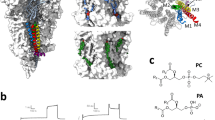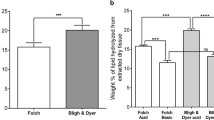Summary
Acetylcholine receptor, isolated in Triton X-100 on a cobra α-neurotoxin affinity column was incorporated into unilamellar phospholipid vesicles by a detergent depletion method using Amberlite XAD-2. Vesicles of an average diameter of 25 nm were formed, as verified by freeze-fracture electron microscopy and gel filtration. 85 to 95% of the α-bungarotoxin binding sites of the reconstituted acetylcholine receptor were oriented towards the outside of the vesicles. In the reconstituted receptor one molecule of residual Triton X-100 per 2.5 α-bungarotoxin binding sites on the receptor molecule could be assessed. The reconstituted protein was not accessible to papain digestion, whereas the pure acetylcholine receptor, solubilized by Triton X-100 was split into smaller polypeptides under the same condition. Reconstituted acetylcholine receptor and receptor-rich membranes did not exhibit the same behavior as measured by use of a potentiometric dye. This is interpreted as an irreversible alteration of at least 95% of the receptors purified in the presence of Triton X-100. Furthermore, it could be shown that the fluorescence intensity changes induced by carbamylcholine in receptor-rich membranes did not reflect ion fluxes, but conformational changes of the protein or a displacement of the dye from the protein.
Similar content being viewed by others
References
Aebi, H. 1974. Katalase.In: Methoden der enzymatischen Analyse. H.U. Bergmeyer, editor. Third edition, Vol. 1, pp. 713–724, Verlag Chemie, Weinheim
Arnon, R. 1970. Papain.Methods Enzymol. 19:226–244
Barrantes, F.J. 1979. Endogenous chemical receptors: Some physical aspects.Annu. Rev. Biophys. Bioeng. 8:287–321
Boheim, G., Hanke, W., Barrantes, F.J., Eibl, H., Sakmann, B., Fels, G. Maelicke, A. 1981. Agonist-activated ionic channels in acetylcholine receptor reconstituted into planar lipid bilayers.Proc Natl. Acad. Sci. USA 77:842–846
Changeux, J.-P., Heidmann, T., Popot, J.-L., Sobel, A. 1979. Reconstitution of a functional acetylcholine regulator under defined conditions.FEBS Lett. 105:181–187
Downer, N.W., Robinson, N.C., Capaldi, R.A. 1976. Characterization of a seventh different subunit of beef heart cytochromec oxidase. Similarities between the beef heart enzyme and that from other species.Biochemistry 15:2930–2936
Epstein, M., Racker, E. 1978. Reconstitution of carbamylcholine-dependent sodium ion flux and desensitization of the acetylcholine receptor fromTorpedo californica.J. Biol. Chem. 253:6660–6662
Gerritsen, W.J., Verkley, A.J., Zwaal, R.F.A., Deenen, L.L.M. van 1978. Freeze-fracture appearance and disposition of band 3 protein from the human erythrocyte membrane in lipid vesicles.Eur. J. Biochem. 85:255–261
Holloway, P.W. 1973. A simple procedure for removal of Triton X-100 from protein samples.Anal. Biochem. 53:304–308
Huganier, R.L., Schell, M.A., Racker, E. 1979. Reconstitution of the purified acetylcholine receptor fromTorpedo californica.FEBS Lett. 108:155–160
Katz, B., Miledi, R. 1972. The statistical nature of the acetylcholine potential and its molecular components.J. Physiol. (London) 224:665–669
Klett, R.P., Fulpius, B.W., Cooper, D., Smith, M., Reich, E., Possani, L.D. 1973. The acetylcholine receptor. I. Purification and characterization of a macromolecule isolated fromelectrophorus electricus..J. Biol. Chem. 248:6841–6853
Laemmli, U.K. 1973. Cleavage of structural proteins during the assembly of the head of bacteriophage T4.Nature (London) 227:680–685
Lindstrom, J., Anholt, R., Einarson, B., Engel, A., Osame, M., Montal, M. 1980. Purification of acetylcholine receptor, reconstitution into lipid vesicles, and study of agonist-induced cation channel regulation.J. Biol. Chem. 255:8340–8350
Lowry, O.H., Rosebrough, N.J., Farr, A.L., Randall, R.J. 1951. Protein measurement with the Folin phenol reagent.J. Biol. Chem. 193:265–275
Lüdi, H., Oetliker, H., Brodbeck, U. 1981. Use of a potentiometric cyanine dye in the study of reconstituted membrane proteins.In: Membrane Proteins. A. Azzi, U. Brodbeck and P. Zahler, editors. pp. 209–219. Springer-Verlag, Berlin-Heidelberg-New York
Monnier, V.M., Fulpius, B.W. 1977. A radioimmunoassay for the quantitative evaluation of anti-human acetylcholine receptor antibodies in myasthenia gravis.Clin. Exp. Immunol. 29:16–22
Moor, H., Kistler, J., Müller, M. 1976. Freezing in a propane jet.Experientia. 32:805
Neubig, R.R., Cohen, J.B. 1980. Permeability control by cholinergic receptors inTorpedo postsynaptic membranes: Agonist dose-response relations measured at second and millisecond times.Biochemistry 19:2770–2779
Rouser, G., Fleischer, S., Yamamoto, A. 1970. Two-dimensional thin-layer chromatographic separation of polar lipids and determination of phospholipids by phosphorus analysis of spots.Lipids 5:494–496
Rüchel, R., Watters, D., Maelicke., A. 1981. Molecular forms and hydrodynamic properties of acetylcholine receptor from electric tissue.Eur. J. Biochem. 119:215–223
Schiebler, W., Hucho, F. 1978. Membranes rich in acetylcholine receptor: Characterization and reconstitution to excitable membranes from exogenous lipids.Eur. J. Biochem. 85:55–63
Schindler, H. 1982. Reconstitution of AChR in planar bilayers.Neurosci. Res. Program Bull. 20:295–301
Schindler, H., Quast, U. 1980. Functional acetylcholine receptor fromTorpedo marmorata in planar membranes.Proc. Natl. Acad. Sci. USA 77:3052–3056
Siegel, L.M., Monty, K.S. 1966. Determination of molecular weights and frictional ratios of proteins in impure systems by use of gel filtration and density gradient centrifugation application to crude preparations of sulfide and hydroxylamine reductase.Biochim. Biophys. Acta 112:346–362
Sims, P.J., Waggoner, A.S., Wang, C.-H., Hoffmann, J.F. 1974. Studies on the mechanism by which cyanine dyes measure membrane potential in red blood cells and phosphatidylcholine vesicles.Biochemistry 13:3315–3330
Sobel, A., Changeux, J.-P. 1977. Purification and characterization of the cholinergic receptor protein in its membranebound and detergent-soluble forms from the electric organ ofTorpedo marmorata.Biochem. Soc. Trans. 5:511–514
Vogel, Z., Sytkowski, A.J., Ninenberg, M.W., 1972. Acetylcholine receptor of muscle grownin vitro.Proc. Natl Acad. Sci. USA 69:3180–3184
Wacker, H., Müller, F., Semenza, G. 1976. Incorporation of hydrophobic aminopeptidase from hog kidney into egg lecithin liposomes: Number and orientation of aminopeptidase molecules in the lecithin vesicles.FEBS Lett. 68:145–152
Waggoner, A.S. 1979. Dye indicators of membrane potential.Annu. Rev. Biophys. Bioeng. 8:47–68
Wu, W. C.-S., Raftery., M.A. 1979. Carbamylcholine-induced rapid cation efflux from reconstituted membrane vesicles containing purified acetylcholine receptor.Biochem. Biophys. Res. Commun. 89:26–35
Wu, W.C.-S., Moore, H.-P.H., Raftery, M.A. 1981. Quantitation of cation transport by reconstituted membrane vesicles containing purified acetylcholine receptor.,Proc. Natl. Acad. Sci. USA 78:775–779
Author information
Authors and Affiliations
Rights and permissions
About this article
Cite this article
Lüdi, H., Oetliker, H., Brodbeck, U. et al. Reconstitution of pure acetylcholine receptor in phospholipid vesicles and comparison with receptor-rich membranes by the use of a potentiometric dye. J. Membrain Biol. 74, 75–84 (1983). https://doi.org/10.1007/BF01870496
Received:
Revised:
Issue Date:
DOI: https://doi.org/10.1007/BF01870496




